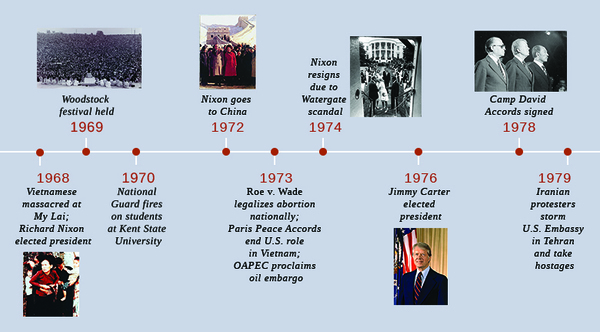| << Chapter < Page | Chapter >> Page > |

The political divisions that plagued the United States in the 1960s were reflected in the rise of identity politics in the 1970s. As people lost hope of reuniting as a society with common interests and goals, many focused on issues of significance to the subgroups to which they belonged, based on culture, ethnicity, sexual orientation, gender, and religion.
In the late 1960s and early 1970s, many young people came to embrace a new wave of cultural dissent. The counterculture offered an alternative to the bland homogeneity of American middle-class life, patriarchal family structures, self-discipline, unquestioning patriotism, and the acquisition of property. In fact, there were many alternative cultures.
“ Hippies ” rejected the conventions of traditional society. Men sported beards and grew their hair long; both men and women wore clothing from non-Western cultures, defied their parents, rejected social etiquettes and manners, and turned to music as an expression of their sense of self. Casual sex between unmarried men and women was acceptable. Drug use, especially of marijuana and psychedelic drugs like LSD and peyote, was common. Most hippies were also deeply attracted to the ideas of peace and freedom. They protested the war in Vietnam and preached a doctrine of personal freedom to be and act as one wished.
Some hippies dropped out of mainstream society altogether and expressed their disillusionment with the cultural and spiritual limitations of American freedom. They joined communes, usually in rural areas, to share a desire to live closer to nature, respect for the earth, a dislike of modern life, and a disdain for wealth and material goods. Many communes grew their own organic food. Others abolished the concept of private property, and all members shared willingly with one another. Some sought to abolish traditional ideas regarding love and marriage, and free love was practiced openly. One of the most famous communes was The Farm, established in Tennessee in 1971. Residents adopted a blend of Christian and Asian beliefs. They shared housing, owned no private property except tools and clothing, advocated nonviolence, and tried to live as one with nature, becoming vegetarians and avoiding the use of animal products. They smoked marijuana in an effort to reach a higher state of consciousness and to achieve a feeling of oneness and harmony.
Music, especially rock and folk music, occupied an important place in the counterculture. Concerts provided the opportunity to form seemingly impromptu communities to celebrate youth, rebellion, and individuality. In mid-August 1969, nearly 400,000 people attended a music festival in rural Bethel, New York, many for free ( [link] ). They jammed roads throughout the state, and thousands had to be turned around and sent home. Thirty-two acts performed for a crowd that partook freely of marijuana, LSD, and alcohol during the rainy three-day event that became known as Woodstock (after the nearby town) and became the cultural touchstone of a generation. No other event better symbolized the cultural independence and freedom of Americans coming of age in the 1960s.

Notification Switch
Would you like to follow the 'U.s. history' conversation and receive update notifications?